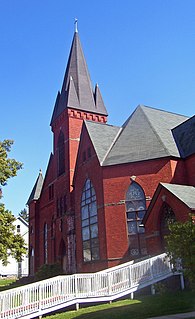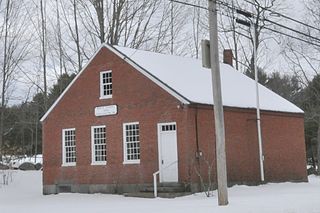
The District Five Schoolhouse, also known as the Fenner Hill School, is a historic former school building at 449 School Street in Webster, Massachusetts. Built in 1835, the one-room schoolhouse was the first school building built by the recently incorporated town of Webster. It served the town as a school for 100 years, after which it was used by the school system for storage. In 1966 it became the museum and headquarters of the Webster-Dudley Historical Society. The building was listed on the National Register of Historic Places in 1991.

The West Ward School is a historic school at 39 Prospect Street in Wakefield, Massachusetts. Built in 1847, it is the only surviving Greek Revival schoolhouse in the town. The building was listed on the National Register of Historic Places in 1989. It is now maintained by the local historical society as a museum property.

Hornby School is a one-room schoolhouse in Greenfield Township, Erie County in the U.S. state of Pennsylvania. The school was one of the ten similar schools constructed in Greenfield Township, and is one of only two one-room schoolhouses remaining in Erie County that are not heavily altered. The schoolhouse was constructed in 1875, and was originally called Shadduck School. Hornby School stayed in continuous operation as a school until 1956. It was restored and opened as the Hornby School Museum in 1984, and was listed on National Register of Historic Places in 2008.

Washington Avenue Historic District is the historic center of Cedarburg, Wisconsin, the location of the early industry and commerce that was key to the community's development. The historic district was listed on the National Register of Historic Places (NRHP) in 1986.

The Historic Walden United Methodist Church is located on West Main Street in Walden, New York, United States. It was desanctified in 2013 and sold by the congregation on November 24, 2014. The current location is at 1206 New York State Route 52, Walden, New York, United States. Ground was broken on a new House of Worship in September 2019 and is scheduled for completion in the spring of 2020.

St. Remy's Catholic Church is a historic Roman Catholic church in Russia, Ohio, United States. Built in 1890, it continues to house an active parish, and it has been recognized as a historic site because of its architecture.

The Greenfield Union School is a school located at 420 West 7 Mile Road in Detroit, Michigan. A part of Detroit Public Schools (DPS), the school building was listed on the National Register of Historic Places in 2011.

Holy Cross Church and Convent is a Roman Catholic church complex in Green Bay, Wisconsin, with six structures built from 1862 to 1932 in various architectural styles. Currently, it is also a church school. The complex was added to the National Register of Historic Places on June 28, 2001 for its architectural significance.

St. Patrick's Church is a historic Catholic church built in 1885 in Eau Claire, Wisconsin. It was added to the National Register of Historic Places in 1983 for its architectural significance.

Saints Peter and Paul Roman Catholic Church Complex is located in Milwaukee, Wisconsin. The complex was added to the National Register of Historic Places in 1991 for its architectural significance.

The East Brady Street Historic District is located in Milwaukee, Wisconsin. It was added to the National Register of Historic Places in 1990.

The Grand Avenue Congregational Church is a historic Romanesque Revival church built in 1888 in Milwaukee, Wisconsin. It was added to the National Register of Historic Places in 1986.

Strang School District No. 36, or the Strang Public School, is a historic school located in Fillmore County, Nebraska, in the village of Strang. The school is one of the two sites listed on the National Register of Historic Places in the village of Strang. The school building is a small, two-story, brick public schoolhouse, which was built to replace the schoolhouse that was previously located on that site. The schoolhouse was built between 1929 and 1930, and replaced the previous schoolhouse, which burned down in 1928. The schoolhouse still retains all original building materials. The school served high school students from 1930 to 1951, and still functions as a school today, serving grades K–8. The NRHP listing also includes a flagpole located outside the schoolhouse, and five pieces of playground equipment.

Powhatan Historic State Park is a 9.1-acre (3.7 ha) Arkansas state park in Lawrence County, Arkansas in the United States. The park contains the 1888 Powhatan courthouse which served as the home of county government from 1869-1968. Today the structure displays items of cultural and historical significance and hosts the park's Visitor Center. The park includes four additional historical buildings and the Arkansas History Commission's Northeast Arkansas Regional Archives. A tour of the historic structures is available. Powhatan served as an important stop for traffic on the Black River until the installation of the Kansas City-Memphis Railwayline two miles north in 1883 significantly decreased the need for river transportation.

The Court Street Commercial Historic District is a largely intact part of the old downtown of Richland Center, Wisconsin. It was added to the National Register of Historic Places in 1989 - a 11.2 acres (4.5 ha) historic district which included 51 contributing buildings and 20 non-contributing ones. The buildings are commercial, mostly in Late Victorian styles constructed from 1870 to 1938. Most are brick two-story buildings; a few one-story and three-story brick buildings are interspersed.

The North School, also known locally as the Brick School, is a historic one-room schoolhouse at 63 Amesbury Street in Kensington, New Hampshire, United States. Built in 1842, it was the only brick schoolhouse built in the town, and is one of its four surviving 19th-century schools. Of those, it is the best-preserved, and is used as a local history museum. It served the town's educational purposes between 1842 and 1956, and is now a local history museum. The building was listed on the National Register of Historic Places in 2013.

The Little Red Schoolhouse is a former school building located in Scottsdale, Arizona. It was originally known as the Scottsdale Grammar School and is now home to the Scottsdale Historical Museum.

The Alpine Elementary School is a compound consisting of four buildings in Alpine, Arizona. The original school building was built in 1930, while the current gym/auditorium was constructed as an LDS chapel in 1939. There are also two more recent constructions consisting of modular buildings, which are not considered as contributing to the historical nature of the site.

The Mazomanie Downtown Historic District is the old downtown of Mazomanie, Wisconsin, with surviving structures built as early as 1857. It was added to the State and the National Register of Historic Places in 1992.

The Old Hanover High School is a former school building located at 105 Fairview Street in Hanover, Michigan. It now houses the Lee Conklin Reed Organ & History Museum. The building was listed on the National Register of Historic Places in 2012.






















